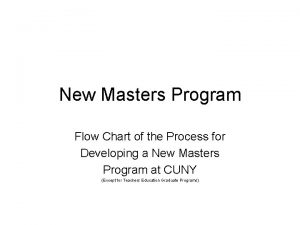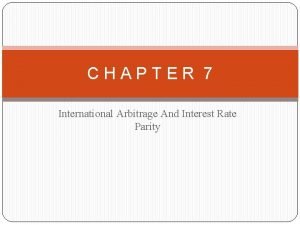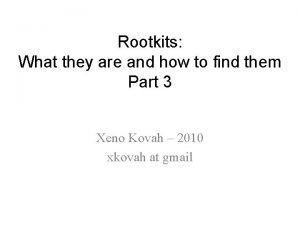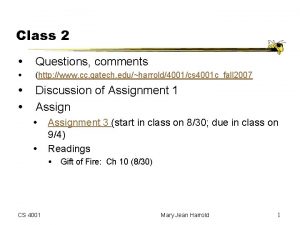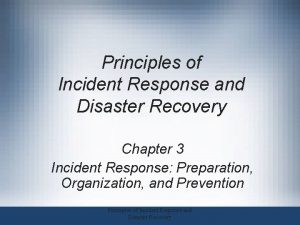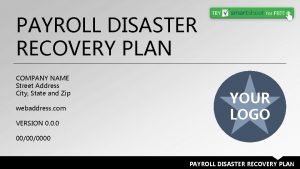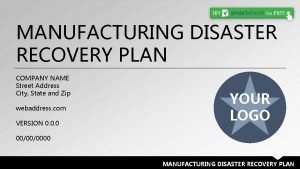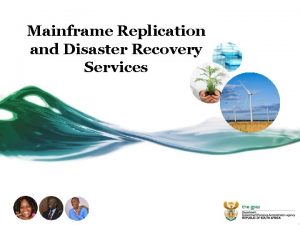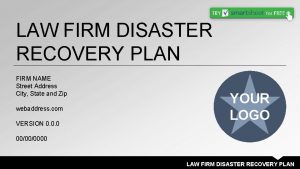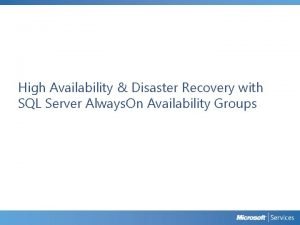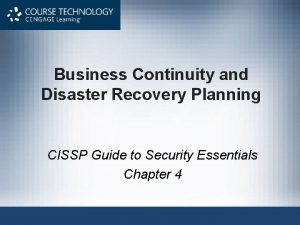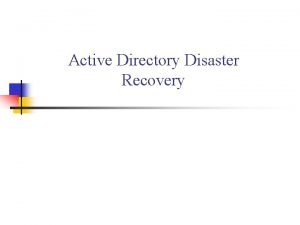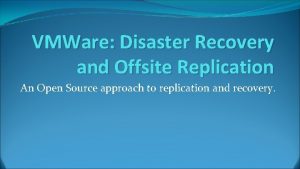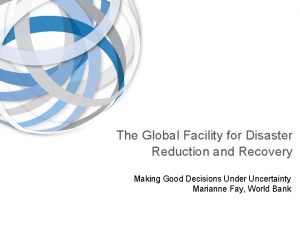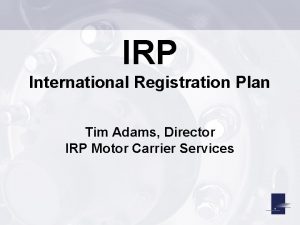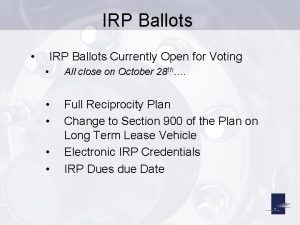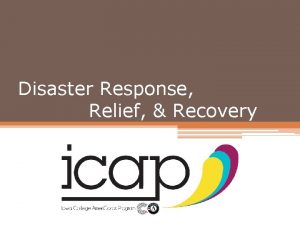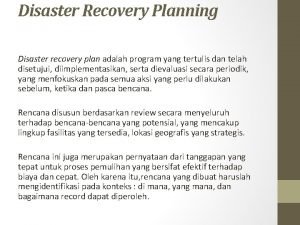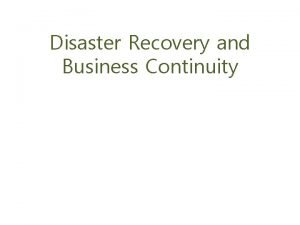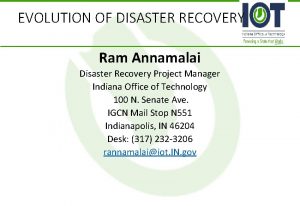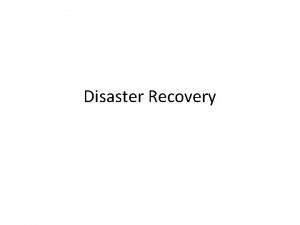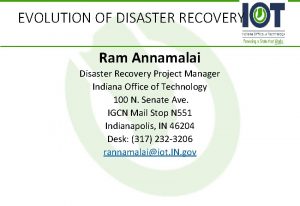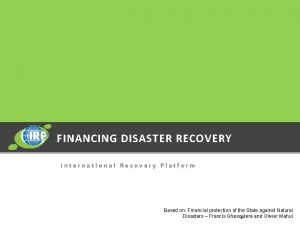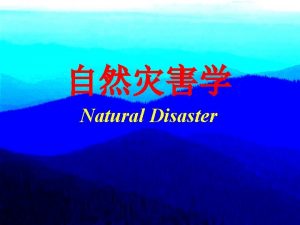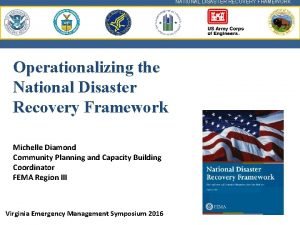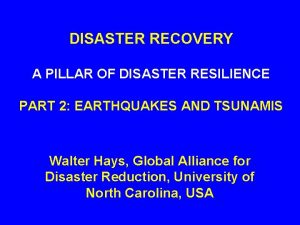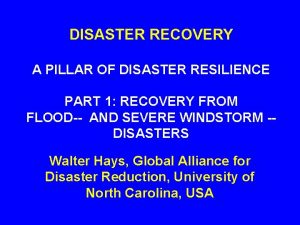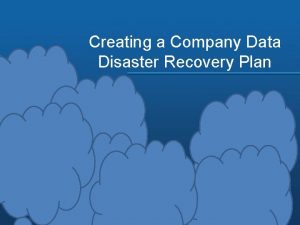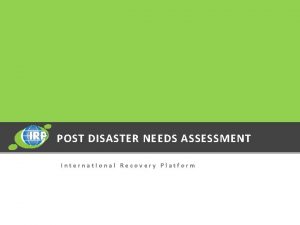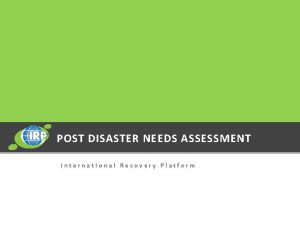Learning from Disaster Recovery International Recovery Platform IRP




























- Slides: 28

Learning from Disaster Recovery International Recovery Platform (IRP) Review of Emerging Lessons

The Indian Ocean Tsunami

Hurricane Katrina

Kashmir Earthquake

What is disaster recovery? “ …. the permanent construction or replacement of severely damaged physical structures, the full restoration of all services, and local infrastructure, the revitalization of the economy and the restoration of social and cultural life. ” An overview of Disaster Management, UNDP, 1991

Who is undertaking this review? n This is a combined operation involving: Government of Japan n UNDP n ISDR secretariat incl. PPEW n ADRC n n The review is being edited by a team led by Professor Ian Davis Resilience Centre, Cranfield University, UK

Why is this learning needed? n Because there is a gap. Currently, there is no documentation that compares disaster recovery lessons across sectors, cultures and hazard types. n To document vital experiences of recovery management in order to share relevant knowledge with those needing it.

n Without this study there is a serious risk of decision makers ‘re-inventing wheels’. n A template is needed to enable future recovery studies to be undertaken to aid comparison and analysis.

The Learning Cycle APPLY IN FUTURE GAIN NEW EXPERIENCE REFLECT ON EXPERIENCE

What aspects of recovery will be examined? Following natural disasters. n Following all main natural hazards. n Recovery in all phases, from early phases to long-term recovery. n All sectors (e. g. livelihoods, shelters) of recovery management. n Administrative patterns to support recovery n Analysis of recovery will follow thematic lines of the project. n

Who are the audience? ALL STAKEHOLDERS: n Government officials responsible for recovery management. n UN staff in agencies with recovery roles (i. e. UNDP, UNICEF, UNESCO, UNCHS, ISDR etc. ) n Staff in International Development Banks.

n n n National and International NGO’s. Private Sector (Construction, Small Business Sector, Agriculture, Financial Investment, Insurance, etc. ). Donors supporting Disaster Recovery.

Three dimensional recovery The review will seek to find lessons concerning the three dimensions of recovery: n n n PSYCHO-SOCIAL ECONOMIC PHYSICAL (including the natural environment)

The review will identify lessons concerning Three dimensional recovery three dimensions of recovery: processes n ic R om So ad cial r dre eh ssi abi ng lita po tion Ps s-t ych rau / rec o/ ma ove So r str cia ess y l. R eco ver y: on The Recovery Process n g d an ssin es al e loc ddr enc ing ic- a equ lish om ons tab con r c -es l e ste Re tiona disa y: ver na irect eco ind n Ec Political Environmental Cultural Context Physical Recovery: Buildings / infrastructure / agriculture / forestry / transport 132

Typical issues to be included

n Long-Term effects of early decisions

‘Temporary Housing’ in Skopje that survived and shaped a city…. 1963 - Skopje

1970 - Skopje

1974 - Skopje

1989 -

n Time Constraints In Recovery


Risk Reduction in Recovery n



How will this be undertaken? Key recovery documents have been assembled to form a data base (currently 56 disaster recovery examples compiled by IRP). n A team of staff in IRP (Hyogo), ISDR Geneva, Platform for the Promotion of Early Warning (PPEW Bonn), Colombia and Oxford will develop the recovery review from December 2005 -April 2006 based on analysis along five thematic lines. n

What will be the result of this exercise? Improved global recovery management n Better understanding concerning the integration of psycho-social, economic, and physical recovery actions. n Advice on ways to incorporate risk reduction into recovery. n Better use of money invested in recovery through an ‘evidence based approach’ based on what works and what fails. n

 International recovery platform
International recovery platform Nysed irp
Nysed irp Amy newman nida
Amy newman nida Where to find irp number on cab card
Where to find irp number on cab card Irp crm
Irp crm Classificazione chicago acalasia
Classificazione chicago acalasia Irp 24
Irp 24 Covered interest arbitrage
Covered interest arbitrage Interrupt affinity policy tool
Interrupt affinity policy tool Vsdatant.sys blue screen windows 10
Vsdatant.sys blue screen windows 10 Portland general electric irp
Portland general electric irp Perbedaan irp, drp dan bcp
Perbedaan irp, drp dan bcp Cs 4001 gatech
Cs 4001 gatech Verizon 140 west street
Verizon 140 west street Principles of incident response and disaster recovery
Principles of incident response and disaster recovery Payroll disaster recovery plan
Payroll disaster recovery plan Backup and disaster recovery mississippi
Backup and disaster recovery mississippi Disaster recovery plan for manufacturing company
Disaster recovery plan for manufacturing company Mainframe disaster recovery services
Mainframe disaster recovery services Law firm disaster recovery plan
Law firm disaster recovery plan Always on disaster recovery
Always on disaster recovery Emc disaster recovery solutions
Emc disaster recovery solutions Records management disaster recovery plan
Records management disaster recovery plan Oracle disaster recovery plan
Oracle disaster recovery plan Cissp disaster recovery steps
Cissp disaster recovery steps Ad disaster recovery
Ad disaster recovery Disaster recovery audit program isaca
Disaster recovery audit program isaca Vmware offsite disaster recovery
Vmware offsite disaster recovery Socio economic trends
Socio economic trends

